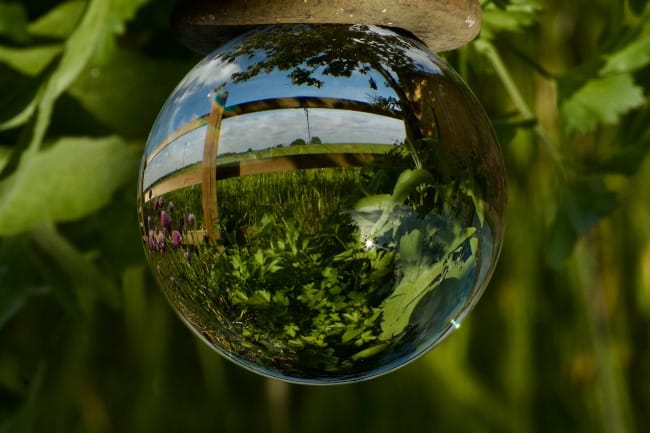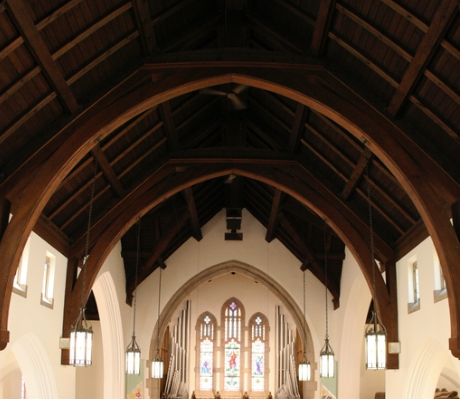Here is the fifteenth installment of our Exodus series. You can take a few minutes to read Exodus 25-31 HERE. You can access the whole series HERE. As always, we will walk through the text and highlight aspects that are not typically noticed, and then conclude with a few themes for ecological discipleship. Thoughts and comments are welcome.
Can't We Just Skip This Part?
The last 15 chapters of Exodus focus almost entirely on building a tabernacle, a portable sanctuary designed to provide a meeting place for God and the people as they move through the wilderness. It is tempting to skip these chapters, and understandable if your eyes glaze over as the construction details are repeated multiple times. It's a lot of ink for a little worship tent!
We have to ask, however, why the author of Exodus dedicated almost one-third of the book to describing the tabernacle. Clearly there is something important about this development in the people of Israel as they transition from being slaves of Pharaoh in Egypt to servants of Yahweh in a new land. There is also much to glean for ecological disciples in our life of faith today. Let's take a look.

A Microcosm of Creation
These chapters offer precise details for each element of the tabernacle: the ark, table, lampstand, bowls, basins, and altar for the inner sanctuary; the courtyard and curtains for the outer space; the oil, incense, and bread for the offerings; the clothing and consecration process for the priests. God clearly cares about the details of worship—there is nothing casual about encountering the Creator!
But there is more going on. This carefully constructed tabernacle is clearly meant to be seen in light of the creation stories of Genesis—in fact, it is meant to be a microcosm of creation. Like the wider creation, the tabernacle is designed to be a divinely-inhabited space created out of chaos. Whereas in Genesis 1, the primal waters are the chaotic force, here it is the wilderness.
Just like the wider creation, the tabernacle is a sanctuary for God, where God's reign will be enacted, God's glory will be palpable, and God's presence will be pervasive. It is also created through a verbal command from God, and God's spirit plays a central role in its formation through the Spirit-inspired work of Bezalel the craftsman and his fellow laborers (31:1-5).
There are seven divine speeches in chapters 25-31, and it takes seven days to ordain the priests—clear allusions to the seven-day creation story. And if that's not enough to help us see the connection, the first account describing the tabernacle ends with a call to keep the sabbath (31:12-17), and the second account begins with a similar exhortation (35:1-3). When the tabernacle is finally completed, Moses inspects every aspect, sees that everything has been created exactly as God intended and blesses it, echoing the blessing God pronounces over the initial creation after seeing that it was "good."
Two other connections are worth noting. First, while the tabernacle is often compared and contrasted with Solomon's temple, less attention is paid to the similarities between the tabernacle and Noah's ark. Both are portable sanctuaries designed to help bring people through physical and temporal chaos to a new land where God's intentions for creation can begin anew. And it's worth noting that the Hebrew word for "ark" is the same word used for the basket that carries baby Moses safely on the Nile. Second, the tabernacle helps Israel's transition to life outside of Egypt. Whereas in Egypt they were forced to build structures for Pharaoh's glory and good, here they are invited to bring offerings (including their labor) to the tabernacle freely. These offerings are honored and celebrated as they build a tabernacle for God's glory and creation's good.
While the tabernacle chapters are repetitive and lack the action of early Exodus, we can see tremendous theological imagination at work. Old Testament scholar Terence Fretheim sums it up this way:
"At this small, lonely place in the midst of the chaos of the wilderness, a new creation comes into being. In the midst of disorder, there is order. The tabernacle is the world order as God intended writ small in Israel. The priests of the sanctuary going about their appointed courses is like everything in creation performing its liturgical service - the sun, the trees, human beings. The people of Israel carefully encamped around the tabernacle in their midst constitutes the beginnings of God's bringing creation back to what it was originally intended to be. The tabernacle is a realization of God's created order in history; both reflect the glory of God in their midst. Moreover, this microcosm of creation is the beginning of a macrocosmic effort on God's part. In and through this people, God is on the move to a new creation for all."
What might this say to us today?

Creating Imaginative Places of Worship
It is important for Israel to have a place set apart for them to meet with and worship the Creator. Such places are typically unique, stable, orderly, grounding, and symbolic. We have seen that God can meet people anywhere, but the tabernacle shows us that humans can construct places to facilitate such meetings, and that the design of these places and spaces matter. For instance, our encounters with God in sanctuaries designed like movie theaters will be different than in sanctuaries with large widows or natural acoustics.
I remember learning that the curved, wooden ceiling of the church where I did my pastoral internship was an intentional reference to Noah's ark. Looking at the roof upside down, it connotes the bottom of a boat and invites us to reflect on our connection to that story (see picture above). I also remember visiting Orthodox churches and seeing how the artwork expresses an interconnected heaven and earth, which includes the people gathering for worship.
Of course, fixed places of worship can also become stifling, confining, and reductive. They can become centers of control for the powerful, and seek to domesticate God and control access to the divine. If God can only be met in a predefined space, whoever controls that space wields tremendous power and influence. With that in mind, the tabernacle offers us something instructive. It stands between the wild, but immovable, Mount Sinai, which hosted God's presence while the people camped at its base, and the temple of Jerusalem, which was built as a permanent residing place for God (but often became a center of corruption and idolatry). The portability, and simplicity, of the tabernacle invites reflection on our own worship spaces and practices.
There is also a profound connection here to Jesus, whose journey is described in John 1:14 this way: "The Word became flesh and tabernacled among us." In Jesus, God's presence journeys along with us in a new and permanent way that is both permanent and dynamic. The apostle Paul connects us directly to Christ's enfleshed, divine presence in 1 Corinthians 6:19: "Do you not know that your bodies are temples of the Holy Spirit, who is in you, whom you have received from God?"
Questions for reflection
How can we construct microcosms of creation that connect us to God's work in creation - past, present, and future? What can help alert us to God's ongoing presence in particular places? How can we use the gifts of creation to help us worship the Creator and move us deeper into God's good purposes for creation? What would it look like to have portable worship elements that could help us connect to God's inner and outer presence in any place, without having to dominate or control the people or places involved?
Here are some ideas and communities that can help you explore these questions. For faith communities who want to gather for worship outside of fixed, human-constructed environments, the Wild Church Network is a creative resource. For more traditional churches who may want to expand their worship practices, I find this simple advice for worshiping outside from the Church of England quite helpful. For churches that want to bring more of the outside inside, creating altar or table displays based on the seasons of the year is a easy way to start. I have also been in a few communion services where fresh bread is actively baking during the service, which, like incense, engages one of the senses rarely used in worship. And for those who want to create microcosms of creation in their homes, Christine Sine instructs us on how to create indoor devotional gardens; you can check out her Advent garden here.
If you have examples or suggestions, I would love to hear from you.
With you on The Way,
James